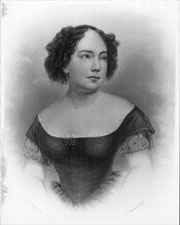Anna Ella Carroll
1815-1894

Anna Ella Carroll was an intriguing and atypical 19th Century woman who emerged from the male-dominated realm of war, politics, and diplomacy.
Anna Carroll, eldest of eight children, was born in 1815 on Maryland's Eastern Shore. Her father Thomas King Carroll, influential in Maryland affairs, was governor in 1830 and 1831. At an early age, Carroll became involved with her father's political and legal activities. Educated and trained by him, she gradually gained entry into the male world of politics.
During an era when women were not expected to do more than write about politics and war, Carroll became active in the Whig party. Through her relationship with President Taylor, and later President Fillmore, Carroll maintained involvement in party development and policy-making. She wrote letters to party officials to influence political decisions. It is said she could "scheme, connive, and maneuver as well as any man."1
When Abraham Lincoln was elected President in 1860, Carroll initially did not have much faith in his leadership. However, as an anti-slavery spokesperson, she celebrated his election by freeing her slaves. A dedicated nationalist opposed to the secession of the Southern states, she turned her political activities towards shaping policy in Maryland and fighting to keep Maryland in the Union. Again, she used news articles and letters to accomplish her purpose. Her pro-union crusade culminated in her efforts to get President Lincoln to plan the future of American Blacks.
Anna Carroll's role as a military strategist during the Civil War was controversial. President Lincoln sent her, accompanied by an army officer, to observe and report on the War on the western front. Her reports resulted in major military strategies that eventually doomed the Confederacy and ended the intervention of the European nations on the behalf of the South. The President and his Cabinet kept her authorship a secret; the public was not to know that the Union plans were devised by not only a civilian, but by a woman.
Carroll continued to advise the federal government and write Union propaganda throughout the War. After President Lincoln's assassination, she devoted her efforts to reconstruction. However, Anna Carroll was largely ignored during those early reconstruction years. She appealed to Congress for recognition and compensation for her contributions to the War effort. Eventually, indirect recognition came in Francis B. Carpenter's 1864 painting of Lincoln and his Cabinet at the signing of the Emancipation Proclamation. The picture shows an empty chair with a folder of maps and notes similar to those Carroll had carried. It is believed that this was Carpenter's way of acknowledging the "unrecognized member of the Cabinet."
In 1881, a bill was finally introduced in Congress to grant recognition and pension to Anna Carroll. The compensation was to be at a rate given to major generals. Unfortunately, President Garfield was assassinated while the bill was under consideration, and House Bill 7256 mysteriously disappeared. Instead, Congress passed a bill to put Anna Carroll's name on the pension rolls and to pay her $50.00 a month for life for the, "important military service rendered by her during the late Civil War."
Even though an invalid in her old age, Carroll continued to write. When the leaders of the Women's Suffrage Movement learned of Anna Carroll's story, they attracted attention to her plight, claiming such an injustice would not have happened if women were allowed to vote.
Anna Ella Carroll died on February 19, 1894. The epitaph on her grave reads, "A woman rarely gifted; an able and accomplished writer."
1. Sylvia Bradley, "Anna Ella Carroll, 1815-1894; Military Strategist - Political Propagandist," in Notable Maryland Women (Cambridge, MD: Tidewater Publishers, 1977), 62-70.
